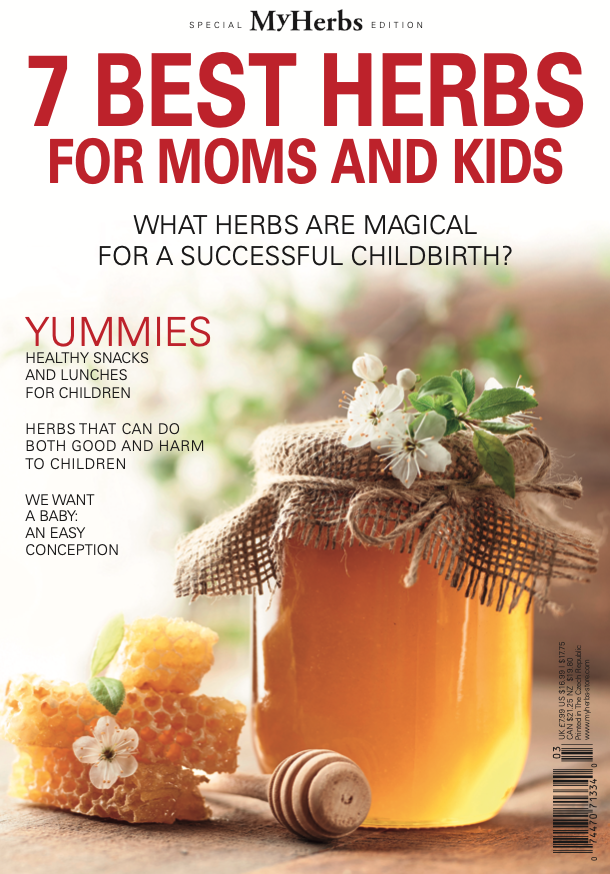Every mom wants the best for her child, and herbs can really contribute toward good health. Which ones should we have at home and which are best avoided?
Using herbs on children has similarly strict rules to using medication. Herbs should be always used in moderate amounts and in exactly defined doses, and one should always carefully study all the possible effects and allergies associated before using them for the first time. Use herbs one at a time at first to easily identify the possible negative reactions and their cause. Keep in mind that in more serious states and illnesses one should always seek out the help of a pediatrician and to listen to their recommendations.
What You Must Remember
It is important to follow several rules. Herbal baths and air fresheners are the best ways to introduce babies to herbs, and be sure always to choose herbs with mild effects. Breastfeeding mothers are at an advantage as they can start using herbs in the first weeks after giving birth, but they should only use the herbs they have already used during pregnancy and have tested.
For a Calmer Tummy
Herbs are most often given to children in the forms of infusions or baths. Breastfed children receive all the materials they need by means of breast milk. It tends to happen that the first herbs a breastfeeding mother seeks out are those that reduce gaseousness. The best helpers in this period are fennel, anise or cumin. Another popular herb is dill, which also has calming effects and improves the sleep of breastfed babies, which is priceless to many new mothers. Children off breast milk that suffer from gaseousness may be served, after receiving a doctor’s permission, a weak fennel or anise infusion. It is also possible to dip a napkin into the prepared infusion and to apply it as warm compressions on the baby’s tummy, gently massaging it in.
Against Skin Problems
If a baby shows symptoms of skin disease, the best way to help is bathing him or her in agrimony infusion. It helps against sores and various kinds of eczema. A similar effect can be achieved by adding weak black tea into a wash tub. To soothe the skin you can also use chamomile or oak bark.
In Times of Colds, Fevers and Coughs
When dealing with colds and coughs, children over six months of age may use black briar, plantain or thyme syrup or infusion. For the smallest children, thyme, mint or clove infusion baths are better. It is recommended to spend five minutes in such a bath. Not only does it have relaxing effects, but it also helps unclog and disinfect the airways.
Herbs against cough and cold symptoms can be also used in meals for children over the age of three. Oregano, marjoram and anise help release phlegm, so feel free to use them even in larger volumes when cooking soups and other meals.
Children’s fevers can be alleviated by means of lilac or linden blooms, or with briar, oak bark or meadowsweet. Sore throats can be combated with thyme or rowan syrup. If it is a vaccination that caused the fever, you can suppress it with yarrow.
The flu is best dealt with using chamomile. This herb has a universally positive effect, it is anti-inflammatory, suppresses pain, and disinfects. It also brings about calming feelings and reinforces the immune system. However, do not use it on children under the age of fourteen months. Chamomile can induce some gaseousness and cause abdominal pain in the smallest of babies. However, when dealing with flu, you can prepare your children an inhalant of thyme, mint, salvia or lavender.
Toothache
Problems associated with growing teeth can be alleviated with althea, chamomile, fennel or salvia. Infusions of these herbs can be also used for a gentle gum massage. Older children may also use a gargling mixture of plantain and agrimony to deal with gum pain and inflammation.
For Calming Down and Improving Sleep
To help children sleep better we can use lemon balm or lavender. Lemon balm is best in the form of tea, whereas lavender can be dripped in liquid form on a child’s pillow. Once you’ve done that let the oil soak into the pillow and allow the aroma to dissipate, so that it doesn’t irritate the child with its intensity. When calming a child down you can also use beechnuts, hops, valerian, lady’s mantle or St John’s wort. To alleviate an older child’s hyperactivity you can use chamomile or red shamrock blooms.
But Never Give Children…
…a herbal mixture whose individual constituents you haven’t yet tried. Otherwise you are risking an allergic reaction. Do not forget that just because a toddler responds well to the leaves of a certain herb it doesn’t mean they may not be allergic to its blooms, and the other way around. Never serve children herbal mixtures containing alcohol or bitter, irritant herbs like licorice, wormwood or centaury. Never serve herbal teas just for the flavor, or for longer than two weeks, and always use them to deal with specific problems. The body may otherwise get used to the effective compounds, which could lead to them later having no effect when actually needed.
Find out more in a beautiful book of 7 Best Herbs for Moms and Kids

